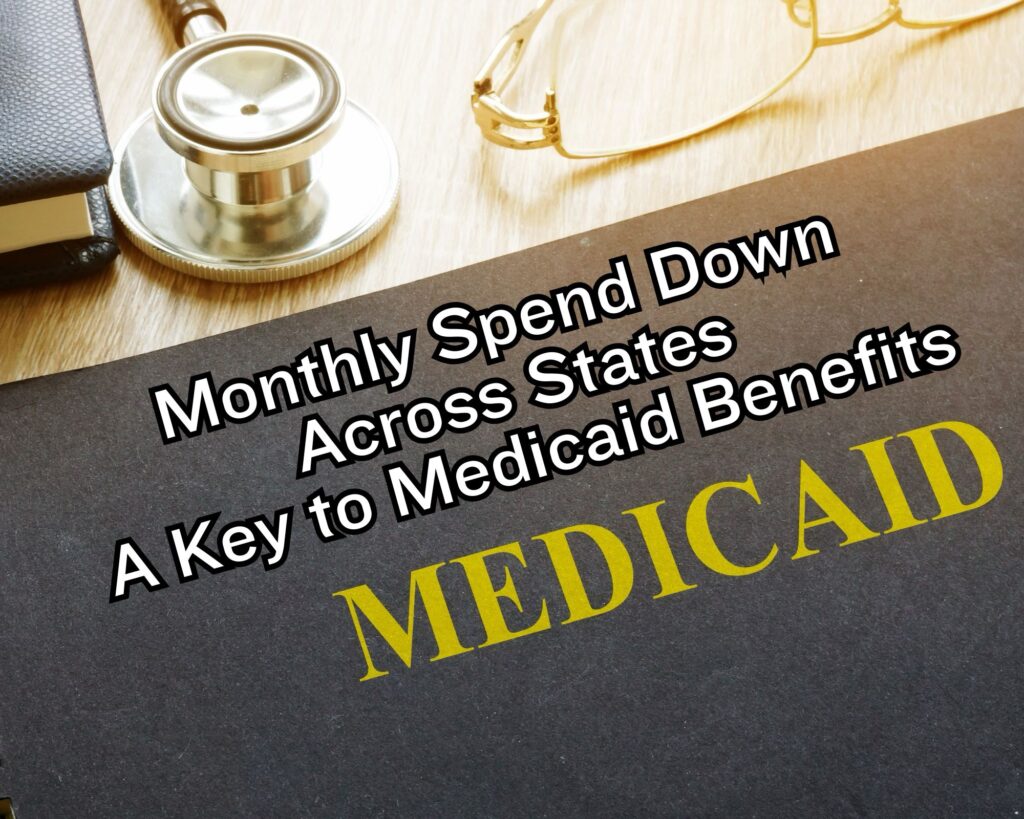In the complex world of healthcare coverage, navigating the nuances of Medicaid can be a daunting task, especially for those hovering just above the income eligibility threshold. Enter the concept of the Monthly Spend Down – a critical mechanism within Medicaid that offers a lifeline to many. Unlike a one-size-fits-all criterion, Monthly Spend Down provides a flexible path to Medicaid benefits for individuals across various states, bridging the gap between income limits and healthcare needs.

In this article, “Understanding Monthly Spend Down Across States: A Key to Medicaid Benefits,” we delve into the intricacies of this crucial component. We will explore what Monthly Spend Down is, how it works, and its significance in enabling access to essential healthcare services for those who find themselves marginally above the income eligibility line. This guide aims to demystify the process, clarify eligibility criteria, and provide practical insights into successfully navigating the Monthly Spend Down system.
What is Monthly Spend Down?
At its core, the Monthly Spend Down program is like a bridge that connects individuals with incomes slightly above the Medicaid eligibility threshold to the comprehensive healthcare coverage they need.
The Basics of Monthly Spend Down
- Function: Monthly Spend Down acts similarly to an insurance deductible. It’s the amount you’re responsible for before Medicaid starts to pay.
- Eligibility: It’s designed for those whose regular income is above Medicaid limits but not high enough to comfortably afford medical care.
A Real-Life Scenario
- Example: Imagine Sarah, a part-time worker whose income is just over the Medicaid limit. Her medical bills for ongoing treatment are substantial. Through Monthly Spend Down, she can subtract her medical expenses from her income, effectively reducing it to qualify for Medicaid.
The Role of Monthly Spend Down
- Accessibility: It ensures that essential healthcare isn’t out of reach for individuals like Sarah, who find themselves in this specific income bracket.
Eligibility and Income Assessment for Monthly Spend Down
Understanding eligibility and accurately assessing income is a pivotal step in the Monthly Spend Down process. Here’s what you need to know:
Determining Eligibility
- Income Criteria: Eligibility for Monthly Spend Down is primarily based on your monthly income. This includes wages, Social Security benefits, and other income sources.
- State-Specific Guidelines: Each state has its own income limits for Medicaid eligibility. Monthly Spend Down is for those who exceed these limits but still struggle with medical costs.
Assessing Your Income
- Total Monthly Income: Calculate all your income sources. This can be from employment, pensions, alimony, etc.
- Documentation: Keep records and documentation of your income, as you’ll need to provide these when applying for Monthly Spend Down.
A Practical Example
- Case Study: John, a retired teacher in Ohio, has a pension that puts him slightly above the Medicaid threshold. By applying for Monthly Spend Down, he can deduct his out-of-pocket medical expenses, such as medication and doctor’s visits, from his income, thereby becoming eligible for Medicaid.
What Medical Expenses Can Be Deducted in the Monthly Spend Down?
Understanding which medical expenses can be deducted is crucial in the Monthly Spend Down process, as it directly impacts your eligibility for Medicaid.
Types of Deductible Expenses
- Doctor’s Bills and Hospital Visits: This includes routine check-ups, emergency room visits, and specialist appointments.
- Prescription Medications: Necessary medications prescribed by your healthcare provider can be counted towards your spend down.
- Home Care Costs: For those requiring in-home medical care, these expenses are often eligible for deduction.
Real-Life Application
- Scenario: Let’s take the example of Emily, a freelance graphic designer in New York. Her income is slightly above the Medicaid limit, but she has ongoing medical needs, including regular medications and physical therapy sessions. By applying her medical expenses to the Monthly Spend Down, she can reduce her countable income to qualify for Medicaid.
Navigating Deductions
- Documentation: Keep meticulous records of all medical expenses. Receipts, invoices, and prescriptions are essential for proof.
- Consultation: If you’re unsure about what qualifies as a deductible expense, consult with a Medicaid representative or a healthcare advisor.
What Are the Pros and Cons of the Monthly Spend Down Program?
While the Monthly Spend Down program is a valuable resource for many, it’s important to weigh its advantages and disadvantages to fully understand its impact.
Advantages of Monthly Spend Down
- Increased Healthcare Access: It enables individuals who are slightly above the Medicaid income limit to access essential healthcare services.
- Flexibility in Medical Expenses: By allowing the deduction of various medical expenses, the program offers flexibility and relief to those with significant healthcare needs.
Disadvantages of Monthly Spend Down
- Complexity of Calculation: Determining eligibility and calculating the spend down amount can be complex and overwhelming for some.
- Variable State Regulations: Since Medicaid is administered by individual states, the rules and income limits for Monthly Spend Down can vary, leading to confusion.
Comparing with Other States
- Variations Across States: For example, states like Illinois might have different income thresholds and deductible expenses compared to states like California. This leads to disparities in how easily individuals can qualify for Medicaid under this program.
A Comparative Scenario
- Example: Comparing two individuals, one from Missouri and one from Texas, both with similar incomes and medical expenses. Due to state-specific guidelines, they may experience different outcomes in their Monthly Spend Down processes.

How Do You Apply for Medicaid After Meeting the Spend Down Amount?
Successfully reaching your Monthly Spend Down amount opens the door to Medicaid benefits. Here’s how to navigate the application process:
Steps for Medicaid Application
- Gather Required Documentation: This includes income statements, medical bills, and proof of your spend down expenses.
- Complete the Medicaid Application: You can apply online, by mail, or in person. Ensure all information is accurate and up-to-date.
Practical Advice for Applicants
- Organize Your Records: Keep a meticulous record of all your documents. Well-organized paperwork can expedite the application process.
- Seek Assistance if Needed: Don’t hesitate to seek help from a Medicaid advisor or use resources available at local health departments.
A Note on Pre-Existing Conditions
- Insurance Solutions for Pre-Existing Conditions: For individuals with pre-existing medical conditions, navigating insurance can be complex. Understanding your options is crucial. For insights on getting approved for insurance with pre-existing conditions, explore “Insurance Solutions for Pre-Existing Medical Conditions: How to Get Approved”.
- Medicaid Considerations: Medicaid generally covers pre-existing conditions, but understanding all your insurance options is beneficial.
Real-Life Example
- Case Study: Consider the case of Mark, a freelance writer in Pennsylvania. After calculating his medical expenses, he reaches his spend down amount. He organizes his bills, fills out the Medicaid application online, and successfully enrolls for coverage.
Applying for Medicaid after meeting the Spend Down amount requires attention to detail and thorough preparation. By following these steps and utilizing available resources, individuals can successfully navigate this crucial phase in the Medicaid process.
Overcoming Challenges in the Monthly Spend Down Process
Navigating the Monthly Spend Down can present challenges, but understanding these obstacles and preparing for them can make the process smoother.
Common Challenges
- Complex Calculations: The process of calculating income and medical expenses can be intricate and confusing.
- Keeping Up with Documentation: Staying organized with all the necessary paperwork is crucial but can be overwhelming.
Tips for Smooth Navigation
- Seek Professional Assistance: Don’t hesitate to consult with a Medicaid specialist or a financial advisor.
- Utilize Online Resources: Many states offer online calculators and resources to help with the Spend Down process.
- Stay Informed: Keep yourself updated on any changes in Medicaid policies or income thresholds in your state.
Conclusion: Navigating to Better Healthcare
The Monthly Spend Down program, despite its complexities, is a vital pathway for many individuals to access Medicaid benefits. By thoroughly understanding the process, meticulously organizing your documents, and proactively addressing potential challenges, you can effectively navigate this system. Remember, the Monthly Spend Down isn’t just about numbers and eligibility; it’s a bridge to essential healthcare services, ensuring that more individuals can receive the medical care they need.
This journey through the Monthly Spend Down process highlights the importance of being informed, prepared, and proactive. With the right approach and resources, navigating Medicaid and its nuances can lead to successful healthcare coverage and peace of mind.
As an Amazon Associate we earn from qualifying purchases through some links in our articles.




